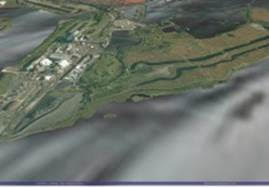Cardiff University has been successfully using GeoVisionary within the MAREN2 project to accurately visualise large LIDAR data sets of water levels, coastal land forms and bathymetry, so stakeholders can assess the impact of proposed renewable energy schemes.
One of the focus areas of this Programme is the feasibility and impact of the development of Marine Renewable Energy by five member states (UK, Ireland, Portugal, Spain and France) which will provide national, local and regional policy makers with accurate information. It is envisaged that the information gathered will help form a coherent, strategic renewable energy policy for the whole Atlantic area. The project is part of the EU Programme INTERREG IVB 2006-2014 Atlantic Area.
Dr Bettina Bockelmann-Evans at The Cardiff University’s School of Engineering explained: “We have looked at two sites – the Bristol Channel and North Wales. There is great potential in both areas for renewable energy, because there is an entirely predictable large tidal range of up to 14m. The modelling data from the virtual tidal lagoons along the North Wales coast and the Severn Barrage is highly accurate and we can closely visualise tidal surges and sea level rise, as well as the impact these structures would have on the environment. Our analysis is so detailed, we can even look at changes of the inter-tidal habitat of wading birds, mud worms, molluscs and seaweed on mud flats.”
GeoVisionary was developed by Virtalis in collaboration with the British Geological Survey (BGS) as specialist software for high-resolution visualisation of spatial data. The initial design goal was to ensure that data sets for large regions, national to sub-continental, could be loaded simultaneously and at full resolution, while allowing real-time interaction with the data in stereoscopic 3D. One of the major advantages GeoVisionary offers over other visualisation software (3 & 4D GIS) is its ability to integrate very large volumes of data from multiple sources, allowing a greater understanding of diverse spatial datasets.
The Cardiff team has discovered that far from exacerbating the existing flood risk, the lagoons along the North Wales coast and the Severn Barrage would actually reduce the flood risk for high tides at Rhyl and in the Newport Levels, respectively. “In Rhyl, a lagoon would entirely protect the coast for the big winter floods that have beset the area in recent years”, said Bockelmann-Evans. “We wouldn’t be able to look at such massive merged bathymetry and terrain models without GeoVisionary. 3D images explain the complex so simply and it is a great way to communicate with people from all walks of life.”
The Project’s Data and Visualisation Consultant, Nick Holden, had been looking for a system that combined geometric accuracy with the ability to handle regional scale data sets for some time when he discovered GeoVisionary at BGS. He said: “We can show effects to the centimetre and below and that level of accuracy generates both confidence and greater understanding. I am now working with the Cardiff team to create an interactive PowerPoint that will contain a series of what-if scenarios and options. In the next phase of the Project, we’ll go further and demonstrate our findings to wider audience in a fully interactive, real time VR environment.”


